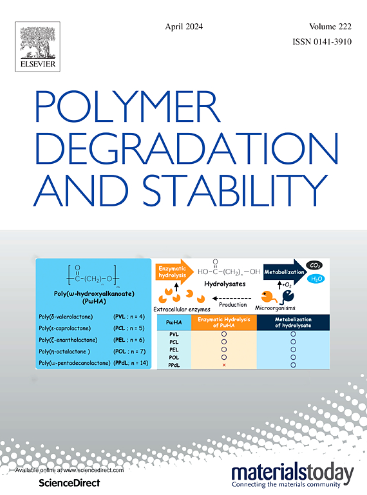Enhanced UV stability of polyimide based on pendent ortho-hydroxybenzophenone UV-absorbing groups
IF 6.3
2区 化学
Q1 POLYMER SCIENCE
引用次数: 0
Abstract
With the trend toward lighter and longer-lasting spacecraft operating in harsh environments, developing advanced high-performance polymer materials with adequate photostability has become an urgent issue. Here, a strategy is proposed to introduce UV-absorbing units as pendent side groups into polyimide (PI) backbone to develop intrinsic PI materials through molecular structure design. Compared with direct incorporation into polymer backbone, this method has a minimal impact on diamine reactivity, enabling the preparation of PI with high molecular weights, and more effectively inhibiting initial UV degradation. The addition of only 5 % of functional monomers for copolymerization can significantly enhance UV resistance while maintaining excellent mechanical and thermal properties. Furthermore, for PI fibers, combining chemical structure with the regulation of the aggregate structure during fiber spinning and heat-drawing process can produce high-performance PI fibers with superior overall properties. Unlike the conventional addition of inorganic nanoparticles or organic UV absorbers, this work aims to establish the relationship between chemical structure, material properties, and UV degradation mechanism. It provides a novel approach from the perspective of molecular structure design for advanced high-performance polymers that require complex processing and stringent performance demands, including long-term UV resistance and mechanical performance.

求助全文
约1分钟内获得全文
求助全文
来源期刊

Polymer Degradation and Stability
化学-高分子科学
CiteScore
10.10
自引率
10.20%
发文量
325
审稿时长
23 days
期刊介绍:
Polymer Degradation and Stability deals with the degradation reactions and their control which are a major preoccupation of practitioners of the many and diverse aspects of modern polymer technology.
Deteriorative reactions occur during processing, when polymers are subjected to heat, oxygen and mechanical stress, and during the useful life of the materials when oxygen and sunlight are the most important degradative agencies. In more specialised applications, degradation may be induced by high energy radiation, ozone, atmospheric pollutants, mechanical stress, biological action, hydrolysis and many other influences. The mechanisms of these reactions and stabilisation processes must be understood if the technology and application of polymers are to continue to advance. The reporting of investigations of this kind is therefore a major function of this journal.
However there are also new developments in polymer technology in which degradation processes find positive applications. For example, photodegradable plastics are now available, the recycling of polymeric products will become increasingly important, degradation and combustion studies are involved in the definition of the fire hazards which are associated with polymeric materials and the microelectronics industry is vitally dependent upon polymer degradation in the manufacture of its circuitry. Polymer properties may also be improved by processes like curing and grafting, the chemistry of which can be closely related to that which causes physical deterioration in other circumstances.
 求助内容:
求助内容: 应助结果提醒方式:
应助结果提醒方式:


